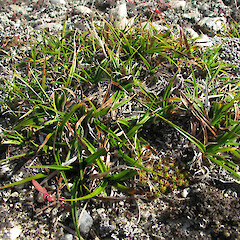Carex breviculmis
Common name
grassland sedge
Synonyms
None
Family
Cyperaceae
Flora category
Vascular – Native
Endemic taxon
No
Endemic genus
No
Endemic family
No
Structural class
Sedges
NVS code
The National Vegetation Survey (NVS) Databank is a physical archive and electronic databank containing records of over 94,000 vegetation survey plots - including data from over 19,000 permanent plots. NVS maintains a standard set of species code abbreviations that correspond to standard scientific plant names from the Ngä Tipu o Aotearoa - New Zealand Plants database.
CARBRE
Chromosome number
2n = c.64
Current conservation status
The conservation status of all known New Zealand vascular plant taxa at the rank of species and below were reassessed in 2017 using the New Zealand Threat Classification System (NZTCS) – more information about this can be found on the NZTCS website. This report includes a statistical summary and brief notes on changes since 2012 and replaces all previous NZTCS lists for vascular plants.
Please note, threat classifications are often suggested by authors when publications fall between NZTCS assessment periods – an interim threat classification status has not been assessed by the NZTCS panel.
- Conservation status of New Zealand indigenous vascular plants, 2017 . 2018. Peter J. de Lange, Jeremy R. Rolfe, John W. Barkla, Shannel P. Courtney, Paul D. Champion, Leon R. Perrie, Sarah M. Beadel, Kerry A. Ford, Ilse Breitwieser, Ines Schönberger, Rowan Hindmarsh-Walls, Peter B. Heenan and Kate Ladley. Department of Conservation. Source: NZTCS and licensed by DOC for reuse under the Creative Commons Attribution 4.0 International licence.
2017 | Not Threatened | Qualifiers: SO
Previous conservation statuses
2012 | Not Threatened
2009 | Not Threatened
2004 | Not Threatened
Distribution
.Indigenous, North and South Islands. Also Australia, New Guinea, Lord Howe and Norfolk Islands
Habitat
Coastal to montane. Usually in open grassland, gum land scrub, clay pans, on rock stacks, and talus slopes and other similar sparsely vegetated sites.
Detailed description
Shortly rhizomatous; tufted sedge usually forming low-growing, close-packed, bright green patches. Culms hidden among leaves, usually 10–20 mm long; basal sheaths dull brown. Leaves much > culms, 1.5–3.0 mm wide, grass-like, recurved, channelled, margins exceedingly finely and closely scabrid almost throughout. Spikes 2–5, approximate, pale green; terminal spike male, usually sessile; remaining spikes female, occasionally with a few male flowers at the top, 6–9 mm long, ± pedunculate, clustered round base of male spike; subtending bracts leaf-like, very narrow-linear, the uppermost almost filiform, margins finely scabrid. Glumes > utricles, ovate, pale green, almost white, membranous, midrib green, stiff, thickened, produced to a stout, finely hispid awn. Utricles c. 2.5 × 1.0 mm, biconvex or subtrigonous, fusiform, pale yellow-green, faintly many-nerved, pubescent all over; beak slightly narrowed, pale green, c. 0.5 mm long, orifice ± truncate; stipe c. 0.3 mm long, often much contracted. Stigmas 3. Nut c. 1.5 mm long, obtusely trigonous, oblong, obovoid, light brown, surmounted by a minute, persistent, dilated style-base.
Similar taxa
Carex breviculmis is one of the earliest flowering New Zealand species and is immediately recognised by its palen-green, faintly nerved, pubescent utricles.
Flowering
August–December
Fruiting
October–May
Life cycle
Nuts surrounded by inflated utricles are dispersed by granivory and wind (Thorsen et al., 2009).
Propagation technique
Easily grown from fresh seed and by division of established plants. In ideal conditions this species sometimes naturalises in urban areas but it is never invasive. Tolerant of a wide range of conditions except permanently waterlogged soils. However does best in full sun in a free draining soil.
Etymology
carex: Latin name for a species of sedge, now applied to the whole group.
Attribution
Fact Sheet prepared by P.J. de Lange (110 August 2006). Description adapted from Moore and Edgar (1970)
References and further reading
Moore LB, Edgar E. 1970. Flora of New Zealand, Volume II. Indigenous Tracheophyta: Monocotyledones except Gramineae. Government Printer, Wellington, NZ. 354 p.
Thorsen MJ, Dickinson KJM, Seddon PJ. 2009. Seed dispersal systems in the New Zealand flora. Perspectives in Plant Ecology, Evolution and Systematics 11: 285–309.
NZPCN Fact Sheet citation
Please cite as: de Lange, P.J. (Year at time of access): Carex breviculmis Fact Sheet (content continuously updated). New Zealand Plant Conservation Network. https://www.nzpcn.org.nz/flora/species/carex-breviculmis/ (Date website was queried)















